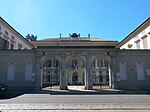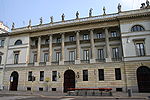Giardini Pubblici Indro Montanelli
Parks in MilanTourist attractions in Milan

Giardini Pubblici Indro Montanelli ("Indro Montanelli Public Gardens"), formerly known as Giardini Pubblici and Giardini di Porta Venezia (and renamed after journalist and writer Indro Montanelli in 2002) are a major and historic city park in Milan, Italy, located in the Porta Venezia district, north-east of the city center, in the Zone 1 administrative division. Established in 1784, they are the oldest city park in Milan. After their establishment, the Gardens have been repeatedly enlarged (to the current overall area of 172.000 m2) and enriched with notable buildings, most notably the Natural History Museum (1888–1893) and the Planetarium (1930).
Excerpt from the Wikipedia article Giardini Pubblici Indro Montanelli (License: CC BY-SA 3.0, Authors, Images).Giardini Pubblici Indro Montanelli
Via Palestro, Milan Municipio 1
Geographical coordinates (GPS) Address Nearby Places Show on map
Geographical coordinates (GPS)
| Latitude | Longitude |
|---|---|
| N 45.474444444444 ° | E 9.2 ° |
Address
Trenino dei Giardini
Via Palestro
20219 Milan, Municipio 1
Lombardy, Italy
Open on Google Maps











